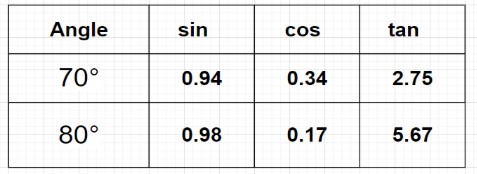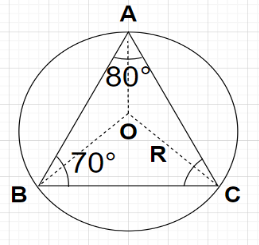Question
Question: In triangle ABC, AB=5 cm, \(\angle {\text{A}} = {80^0}\) and \(\angle {\text{B}} = {70^0}\). Calcula...
In triangle ABC, AB=5 cm, ∠A=800 and ∠B=700. Calculate the radius of the circumcircle and length of the other two sides. (Necessary values can be taken from the following table)

Solution
Hint: Here, we will proceed by using the property of the triangle i.e., the sum of all the interior angles of any triangle is always 1800 and then we will use the formula of extended sine rule i.e., sinCAB=sinABC=sinBAC=2R.
Complete step-by-step answer:

Given, in triangle ABC, AB=5 cm, ∠A=800 and ∠B=700
Let R cm be the radius of the circumcircle of the triangle ABC and O be the centre of this circumcircle.
i.e., OA=OB=OC=R cm
As we know that the sum of all the interior angles of any triangle is always 1800
For triangle ABC,
∠A+∠B+∠C=1800 ⇒800+700+∠C=1800 ⇒∠C=1800−(800+700) ⇒∠C=1800−1500 ⇒∠C=300
Also we know that according to the extended sine rule
sinCAB=sinABC=sinBAC=2R →(1)
By substituting the known values, equation (1) becomes
sin3005=sin800BC=sin700AC=2R →(2)
According to the given table, sin800=0.98 and sin700=0.94
According to the general trigonometric table, sin300=0.5
Now, substitute the above values in equation (2), we get
By equation (3), we can write
10=2R ⇒R=210 ⇒R=5 cmSo, the radius of the circumcircle of the triangle ABC is equal to 5 cm.
By equation (3), we can write
So, the length of side BC of the triangle ABC is equal to 9.8 cm.
By equation (3), we can write
So, the length of side AC of the triangle ABC is equal to 9.4 cm.
Note: In this particular problem, with the help of the given table we are only using the values of sin800=0.98 and sin700=0.94 whereas the other values are not used for the evaluation of the parameters asked. Here, we have used the extended sine rule because we know the values of all the interior angles and the length of one side.
